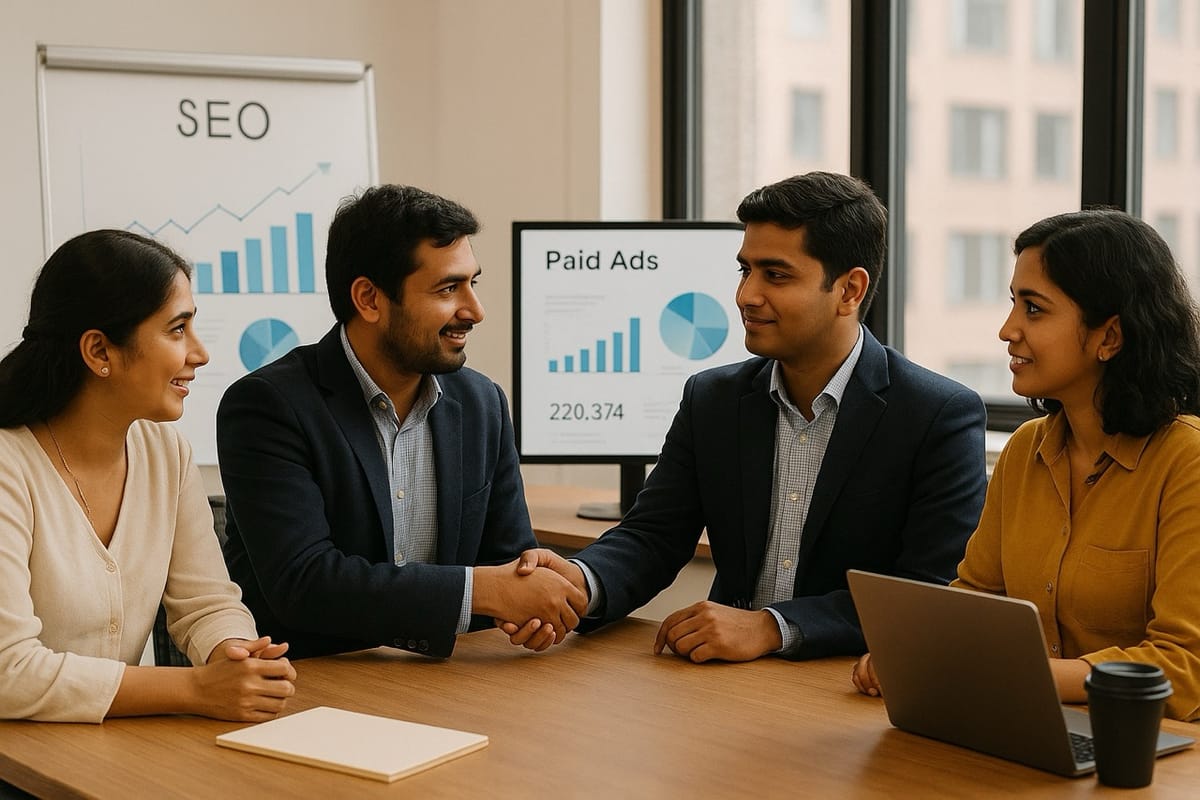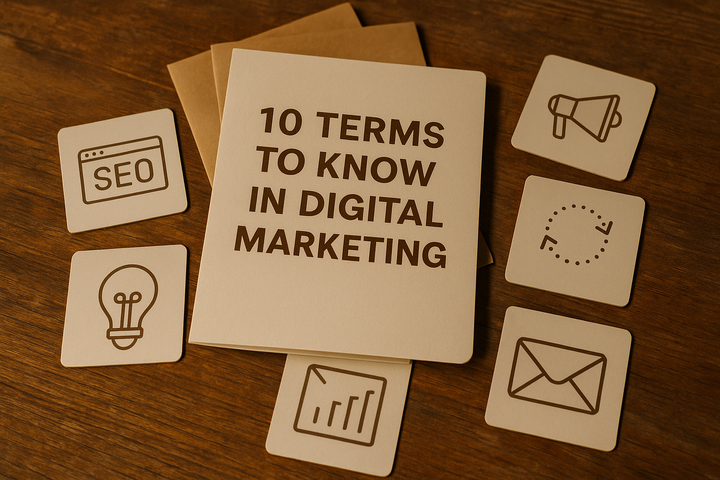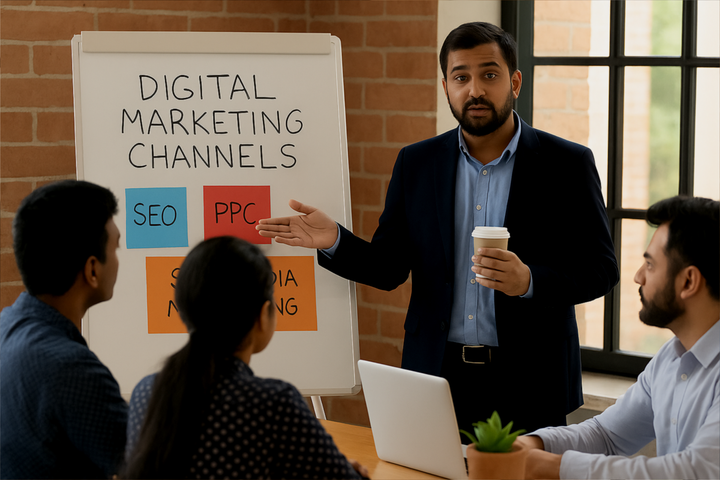SEO vs Paid Ads: Which One Should You Focus on First?
Balancing SEO and paid ads is crucial for retail growth; both strategies offer unique advantages for attracting customers effectively.

Imagine you’ve just launched an online retail store. You have a beautiful website, great products, and a small budget for marketing. Now comes the dilemma: SEO vs Paid Ads – which one should you focus on first to get customers through your virtual doors? This question is like choosing between planting a seed for long-term growth or grabbing a quick burst of traffic. In my experience as a digital marketing specialist, I’ve seen businesses thrive with both approaches.
I remember working with a local event organizer firm that struggled with this very choice. They wondered if they should invest their limited resources in creating content to rank on Google, or spend that money on immediate advertisements. It’s a tough call, but understanding the strengths of SEO and paid ads will help you make an informed decision for your retail business and beyond.
Understanding the Basics of Each Strategy
Let’s start by breaking down what SEO vs Paid Ads really means. Search Engine Optimization (SEO) is the art and science of getting your website to show up naturally in search results. When someone searches for “comfortable running shoes” on Google and clicks a non-ad result, that’s thanks to SEO. It involves experience-driven tweaks to your website’s content and code so that search engines trust it as authoritative and relevant. With SEO, you’re not paying for each click. Instead, you invest time (and sometimes money) to optimize your site. Over time, if done right, your pages climb up the rankings and attract shoppers organically. It’s a bit like planting an apple tree: you water it and wait patiently, and eventually you’ll have lots of free fruit.
On the other hand, Paid Ads (often known as pay-per-click or PPC ads) are more like paying for instant results. If SEO is planting a seed, paid ads are buying a blooming plant from the store. For example, you can pay Google to display your shoe store at the top of search results when someone types “buy running shoes online.” Those results tagged with “Ad” are not there by accident – the retailer is paying for that prime spot. Every time a potential customer clicks the ad, you pay a fee. This strategy relies on budget more than time. It’s often used when you need immediate visibility or want to target specific promotions and keywords quickly. Crucially, paid ads can bring traffic overnight, whereas SEO might take months to show significant results.
However, the moment you stop funding ads, your visibility vanishes just as quickly. In contrast, a good SEO foundation keeps working round the clock. Many retail businesses use a mix of both: they run ads for quick wins and work on SEO behind the scenes for sustainable growth. Understanding SEO vs Paid Ads at a basic level comes down to this: SEO builds long-term equity in your online presence, and paid ads provide short-term boosts.
The Retail Industry Perspective
Now let’s talk about how this duel plays out in the retail industry. Picture a small fashion boutique called StyleHive that sells trendy clothing both in-store and online. StyleHive’s owner, Jane, has to decide where to put her limited marketing dollars – into improving her website’s SEO or launching Google and Facebook ad campaigns. She’s not alone in this puzzle. Retail is super competitive, and we’ve seen countless shops ask the same question of SEO vs Paid Ads.
Jane’s instinct is to get people on her site quickly, especially with a seasonal sale coming up next month. So, she considers paid ads. By using Paid Ads, StyleHive could appear at the top of search results for “summer dress sale” next week rather than hoping to rank organically by then. That immediacy is gold during a short-term promotion. In fact, about 75% of brands report that pay-per-click advertising is a major driver of their business, precisely because it can generate targeted traffic in a hurry. Jane could set a budget, pick keywords (like “boho summer dress”), and see hundreds of new visitors within days. She would likely notice an uptick in online orders as soon as the campaign runs. This kind of quick result can feel like magic for a small retailer.
However, Jane also knows that once her ad budget runs dry, those visitors will disappear. She recalls hearing that when ads for a store stop, the drop in traffic is immediate and steep. On the flip side, building up SEO is slower but steadier. Jane’s friend runs a bookstore and invested in SEO by writing blog posts about reading tips and optimizing his product pages. He mentioned that it took about six months, but now most of his web store’s visitors come from Google searches without him spending a dime on ads. That long-term payoff is the allure of SEO for retail. If StyleHive’s website ranks high for keywords like “trendy summer dresses” or “best boutique in [her city]”, she could attract shoppers continuously. Data backs this up: around 53% of all web traffic comes from organic search, far outpacing traffic from paid ads. People trust those organic results; they often click a store’s site because it’s on page one and seems reputable, not just because it paid to be there.
Moreover, SEO helps with local retail visibility. Think about when you search for a store “near me” – Google’s map results and reviews show up thanks to local SEO efforts. Jane could optimize StyleHive’s Google Business profile so that local shoppers find her boutique when they search for “clothing stores in downtown.” That’s something ads alone can’t sustain for the long haul without a continuous spend.
In retail, the pattern I’ve seen with many businesses (including ones I’ve worked with) is often the same. They use paid ads to jumpstart traffic and sales in the early days or during critical promotions. At the same time, they invest in SEO so that over time, they can rely less on ads. It’s not an all-or-nothing fight. A savvy retailer balances both, treating paid campaigns as short-term boosters and SEO as a way to build a reliable, organic customer pipeline.
Long-Term vs Short-Term Gains
Let’s delve deeper into the timeline differences of SEO vs Paid Ads. Perhaps the biggest trade-off between the two is time versus money. SEO is a long-term game. When you optimize your site or publish a blog post today, you likely won’t see a surge of traffic tomorrow. Instead, search engines gradually start to notice your improvements. Over weeks and months, your pages might climb from, say, page 5 of the search results up to page 1. It requires patience, but the reward is lasting. Once you’ve secured a top spot organically for “vintage denim jacket” or “affordable furniture store,” it can keep bringing in visitors daily with no ongoing ad costs. One study found that SEO typically offers 25% higher ROI than PPC in the long run, precisely because those organic clicks don’t incur a fee.
Paid Ads are the opposite in terms of timing. They’re the quintessential short-term win. If you have a new product launch or a holiday sale next week, PPC is your friend. You can bid on “Black Friday deals at StyleHive” and ensure your ads show up to shoppers searching right when it matters. The results are practically instantaneous. For a retail business trying to meet a quarterly sales target, that speed is invaluable. However, there’s a catch: you are essentially renting attention. The day you decide to stop paying for that ad space, your presence in those sponsored slots is gone. It’s like renting a billboard – when the lease is up, someone else’s ad goes up in lights and yours fades away.
From a short-term perspective, SEO can feel frustrating. You might pour effort into an SEO campaign and hear crickets for a while, which is tough for a business owner eager for quick results. Meanwhile, paid ads could be pulling in customers immediately. On the other hand, if you never invest in SEO, you’re stuck on a treadmill of paying for each and every visitor. That can become expensive and unsustainable, especially for small retailers with thin margins.
A balanced view recognizes that SEO and PPC can complement each other across timelines. While you’re waiting for your SEO efforts to bear fruit, PPC fills the gap. I often advise clients to use PPC data to inform SEO, too. For instance, if a particular ad for “waterproof boots” gets a ton of clicks and sales, that’s a signal to focus your SEO content on that product or keyword as well. The short-term feedback from ads can guide your long-term content strategy. Meanwhile, as your organic traffic grows, you might scale back ad spend on keywords where you already rank #1. Think of it like flying a kite: SEO is the wind that keeps it up steadily, and PPC is the initial lift (and occasional gust) you need to get it off the ground or keep it aloft during lulls. Both together can keep your business soaring throughout the seasons.
Costs and ROI
Money talks, especially in retail where margins can be tight. So, which gives you more bang for your buck: SEO or paid ads? The answer can depend on your situation, but let’s break down the typical cost considerations and return on investment (ROI) for SEO vs Paid Ads.
With SEO, the costs are usually front-loaded and involve sweat equity (or hiring talent). You might pay a content writer to craft an informative article about “10 Best Winter Jackets for 2025” to draw in shoppers, or hire an SEO expert to fine-tune your site’s structure. Additionally, you might invest in tools or an agency to help with keyword research and link building. These costs can add up, but the crucial thing is they are not tied to each individual visitor. Whether that blog post brings in 100 visitors or 10,000 visitors from Google, you’re not paying more for those extra clicks. Over time, if your SEO work is successful, the cost per visitor actually drops dramatically because your one-time investment keeps yielding traffic. That’s why many marketers love SEO – it can continue to generate sales long after the initial work, creating a compounding effect. In fact, on average, businesses often see better cost-effectiveness from SEO in the long run. One analysis found that small businesses investing in SEO enjoyed around 25% higher ROI than PPC – again due to those “free” organic visits. The trust and credibility built by appearing in organic results translate into valuable traffic that doesn’t drain your budget with each click.
When it comes to paid ads, the cost model is straightforward: you pay for performance, usually per click. If the keyword you want is highly competitive – say every fashion retailer wants to show up for “little black dress” – the cost per click could be several dollars. For instance, StyleHive might set aside $500 for a month’s campaign. If each click costs $1, that’s 500 potential customers visiting her site from the ad. This direct control over spend is both comforting and deceiving. It’s comforting because you can scale up or cut back easily; you always know what you’ll pay for a certain number of visitors. But it can be deceiving because those costs can skyrocket if not managed carefully, and not every click turns into a sale. If only 2% of those 500 clicks buy something, that’s 10 sales for $500 spent – the profit from those sales needs to outweigh the ad cost, or else you’re at a loss.
However, the upside of PPC is the potential for immediate ROI when done right. Many businesses see a solid return like, say, $2 in revenue for every $1 spent on ads. That’s an attractive 200% return on ad spend (ROAS) if it holds true. The key is optimizing your ad targeting, using compelling copy, and having a website that converts visitors to buyers once they click through. For retail, platforms like Google Ads or Facebook Ads let you aim at very specific audiences. Specifically, you can target women aged 18–34 in your city who are interested in “fashion.” This means the traffic you pay for can be highly qualified. As a result, those visitors might be more likely to buy than a random organic visitor. Some data even suggests visitors who come via paid search are 35% more likely to convert than those who come via organic links, likely because the ads zero in on people with high purchase intent.
That said, relying solely on PPC can feel like chasing the next sale without building customer loyalty. Over time, costs often rise (popular keywords get pricier), and you may find yourself spending more to get the same results. Therefore, SEO is typically the smarter play for long-term profitability, while PPC is the go-to for immediate, trackable returns and quick market entry. The best retail marketing plans weigh these factors, combining both to maximize ROI at different stages of business growth.
Trust and Credibility
Beyond numbers and traffic, there’s an important human element to consider: how SEO and paid ads each affect your brand’s credibility. This is where the concept of E-E-A-T (Experience, Expertise, Authoritativeness, Trustworthiness) comes into play. While we won’t get too academic here, the gist is that people (and search engines) tend to favor content that demonstrates real experience and expertise. So how do SEO and PPC stack up when it comes to winning customer trust?
Think about your own behavior online. When you search for a product or an answer, and Google presents you with a list of results, which are you more inclined to click: the one that’s an advertised result or one of the top organic results? If you’re like most consumers, you might skip past the ads and click an organic listing first. That’s common – users inherently trust Google’s organic rankings to give them the best answer or the best store. Being at the top of those natural results confers a badge of authority. In fact, studies have shown that the #1 organic result gets a significantly higher click-through rate than even the top ad. Users have learned that anyone can pay for an ad spot, but earning the top organic spot means the site likely has strong content or products. Moreover, about 63% of users assume that the businesses in the top organic spots are well-known brands (Ending the SEO vs. PPC Debate: What You Need To Know - AgencyAnalytics), whether that’s true or not. This psychological effect means SEO can boost your brand’s credibility substantially. When StyleHive appears on page one organically for “quality handmade dresses,” it’s as if the internet is vouching for her boutique.
Paid Ads, by contrast, carry a little “buyer beware” tag in the eyes of savvy consumers. Seeing the word “Ad” might make a shopper pause and think, “This company is trying hard to sell me something.” That doesn’t mean they won’t click – millions do, every day – but the trust isn’t automatic. You have to earn it after the click, with a great landing page and product experience. However, there’s also a flip side: ads can increase your visibility and brand awareness. Even if someone doesn’t click an ad, just the fact that your store’s name is repeatedly showing up for various searches can imprint your brand on their mind. I’ve had clients tell me, “We ran ads all summer, and even people who found us organically later recognized our name because they saw our ads before.” So, PPC can indirectly boost credibility through repetition and coverage, especially if your ads consistently appear alongside industry big players.
For retail, trust is everything. Customers are about to hand over their credit card info; they need to feel confident. SEO plays into this by often bringing in visitors through channels like helpful blog posts, how-to guides, or high Google rankings – all signals that your brand is an authority. A content-rich site with expert advice and customer testimonials (which help with SEO) can make a shopper feel at ease. Paid Ads can also build trust if used to showcase credibility signals (“Rated #1 boutique in NYC!” in the ad text, for example). But a mismanaged ad campaign (like an ad leading to a poorly designed page or an irrelevant product) can actually harm trust quickly.
From an E-E-A-T perspective, consistently producing quality content and useful information will help your SEO and also give you material to use in ads. If you have a knowledgeable blog article on how to style that “little black dress” you’re selling, it might not only rank well but also serve double duty. For example, you could reference it in an ad or a social post to show that you’re not just selling but also educating. That combination of expertise and helpfulness builds trust over time.
In summary, SEO is your long-term trust builder – it’s like word-of-mouth on the internet, slow but very persuasive. Paid Ads are more like billboards – they grab attention, but viewers might be a bit more skeptical until you prove your value. The strongest retail brands use SEO to solidify their reputation as the go-to source in their niche, and use PPC tactically to amplify that message to a wider audience.
Which One Should You Focus on First?
After weighing all these factors, it’s time to address the big question head-on. If you’re just starting out or have limited resources, should you focus on SEO or paid ads first? The honest answer, based on experience and industry evidence, is: it depends on your immediate goals, but you’ll likely need a bit of both eventually.
For a brand-new retail business with zero online presence, running some paid ads is often the jumpstart needed to get initial traffic and sales. It’s hard to be patient when you need cash flow. Paid ads can put you on the map literally overnight, which is fantastic for validating your products and starting to build a customer base. In one example, StyleHive was an unknown brand. A few well-placed Google search ads and Instagram promotions started driving visitors who had never heard of her boutique otherwise. That quick validation is not only motivating for Jane as an owner, but also provides valuable data. She can see which products people clicked on, which keywords convert, and even gather first customer reviews (which later help SEO). If you have a time-sensitive event – like a grand opening or a holiday sale – focusing on PPC first makes a lot of sense.
Conversely, if your goal is to build a sustainable brand that grows steadily, you should focus on SEO as early as possible. The sooner you start creating quality content, optimizing product pages, and earning trust from search engines, the sooner you’ll climb those rankings. Remember, every month of delay in SEO is a month later you’ll see results. From a retail perspective, think about the seasonal cycle: if you want organic traffic for the next holiday season, you should be laying the groundwork months in advance. Focusing on SEO first is like investing in a retirement fund; it’s not about immediate gratification, but your future self (and business) will thank you. Plus, content and optimizations you do now can continue to bring in traffic year after year.
In fact, many marketing experts conclude that it’s not a binary choice. A wise approach is to do both in tandem if you can – perhaps devote 70% of your early effort to SEO and 30% to PPC (or vice versa depending on your needs). In practice, you might start by fixing your website’s SEO basics and publishing a couple of really good, keyword-rich articles. That will kick off the slow burn of organic growth. At the same time, you can launch a small ad campaign for your top products to get immediate eyeballs. Over time, monitor what’s working best. If you find that your organic traffic is picking up and bringing in good sales, you can redirect some ad budget elsewhere. Conversely, if you see that certain ad campaigns have great ROI, keep them running while still growing your organic reach.
In the retail industry, I’ve observed that those who focus on SEO first often enjoy a snowball effect of cumulative growth – their website becomes a magnet for shoppers via Google, reviews, and useful content. Those who focus on Paid Ads first gain quick wins and brand exposure, which can be parlayed into long-term gains if they reinvest some of that success into SEO. Ultimately, the savvy answer is usually “do both, smartly.” SEO is your digital reputation – it grows with consistent effort and proves your expertise and trustworthiness to both customers and search engines. Paid Ads are your megaphone – they amplify your message and bring in crowds when you need them. For retail businesses especially, a blend of the two often yields the best outcome. SEO builds a foundation of loyal, organic customers, while paid ads provide agility and quick impact when you need to drive sales or launch something new. Focus on one or the other first based on your immediate needs, but remember that they work best hand-in-hand. By leveraging the long-term strength of SEO and the short-term punch of paid advertising, you’ll position your business to capture both hearts and clicks – now and in the years to come.



Comments ()